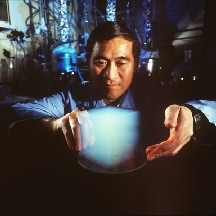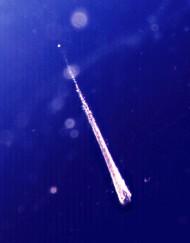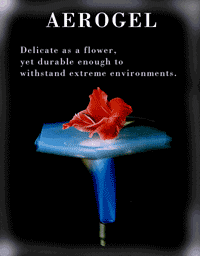

To catch comets in space, Peter
Tsou at JPL (one of the Halley team members) was
determined to develop a means for what he called
"intact capture". The idea was to use
a "soft" capture material that would
allow capture of particles without them being
strongly heated.
Dr. Tsou began a long term development
of materials that could capture small high speed
particles. He started out using plastic foams
to capture particles launched by a high speed
"light gas gun" facility at the NASA
Ames Research center.  When
this effort began it was widely thought that high
speed "intact capture" was impossible
and that the efforts were doomed to failure. Years
of effort showed that it was possible and the
program eventually evolved to use ultra low density
aerogel, a material first developed at the University
of the Pacific in the 1930's. When
this effort began it was widely thought that high
speed "intact capture" was impossible
and that the efforts were doomed to failure. Years
of effort showed that it was possible and the
program eventually evolved to use ultra low density
aerogel, a material first developed at the University
of the Pacific in the 1930's.
Silica aerogel is a wonderfully
transparent material composed of very tiny silica
particles bonded to each other to form an ultra
low density microporous solid. Aerogel can be
custom made with density that ranges from that
of solid glass to that of air ( a thousand times
less dense).  This
is a very strange material that is often referred
to as frozen smoke because of it blue haze and
near lack of mass. Peter made aerogel, tested
it in many ground based experiments and flew in
into space piggybacked onto a variety of experiments
launched and recovered by the Shuttle. This
is a very strange material that is often referred
to as frozen smoke because of it blue haze and
near lack of mass. Peter made aerogel, tested
it in many ground based experiments and flew in
into space piggybacked onto a variety of experiments
launched and recovered by the Shuttle.
Comet sample return missions using capture media
were proposed many times but like most space proposals
they were not accepted. Missions based on this
idea were also proposed by Japan and Europe. The
mission was finally selected as the fourth mission
in the NASA Discovery program. The Discovery program
was started by NASA to enable small low cost rapid
development missions, a perfect match with the
comet sample return via flyby concept.
Back to: Captain
Comet
Last updated November
26, 2003 |
|
